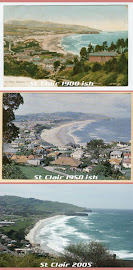By RYAN EVANS ryan.evans@tnl.co.nz - Taranaki Daily News | Tuesday, 18 March 2008
source link
Taranaki's world-renowned surf breaks are set to receive official recognition in the region's new policy statement.
The New Plymouth Surfriders' Club says the region's waves should be protected as virtually irreplaceable natural features and a submission to the Taranaki Regional Council calls for policies protecting the breaks, their water quality and public access.
"Outside of Hawaii, Taranaki has more quality breaks per kilometre than anywhere else in the world," club secretary Allen Pidwell says. "With the shape of our coast, it makes it almost like an island with a number of world class breaks. It's really quite unique."
Mr Pidwell says the breaks need protection from physical developments such as coastal dredging or aquaculture farms and from coastal subdivisions which can restrict access.
The TRC has proposed changes to the draft statement to reflect the club's submission, meaning any future coastal plans must consider the breaks as natural features needing protection.
The TRC has also highlighted the need for consultation and agreement with landowners over access.
Pic from (www.lostinthe60s.com)
Mr Pidwell says the surf breaks are vital to the region's character and economy through the success of advertising and the Surf Highway 45 concept.
"If you don't protect your natural features, then why advertise it? It's the same as the mountain and the national park."
The Regional Policy Statement provides guidelines on environmental matters throughout Taranaki and is required for all regional councils under the Resource Management Act 1991.
Taranaki's existing policy statement was the first to be approved in New Zealand and has been effective since 1994.
The 10-year review of the statement began in 2003.
There were 35 submissions received, including the New Plymouth Surfriders' Club's, when submissions closed in November 2006. A further 21 secondary submissions were then received by the closing date in April last year.
The TRC's report on submissions, including proposed changes to the statement, will now be sent out to all submitters for consideration.
Pre-hearing meetings will be held over the next two months before any changes are adopted.
___________________________I can't support enough the members of the New Plymouth Surfriders' Club's, having the vision to protect that which they value, their surfbreaks. If only more clubs around New Zealand had the same vision.


